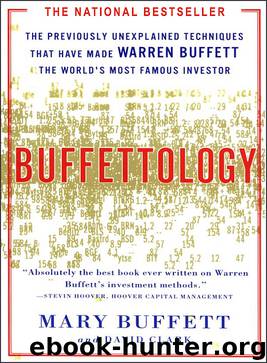Buffettology: the Previously Unexplained Techniques That Have Made Warren Buffett the World's Most Famous Investor by David Clark & Mary Buffett

Author:David Clark & Mary Buffett [Clark, David]
Language: eng
Format: epub
Publisher: Scribner
Published: 1999-03-19T05:00:00+00:00
22
Inflation
To fully understand Warren’s investment philosophy, you need to have an idea of what inflation is and how it is caused. To do this, you have to have an idea of what money is and how it works.
Long ago people traded goods with one another for different products and services: a pig for a plow, wheat for fish, a bit of wool to the local priest for a blessing. People found that it was hard to transport all this stuff around, so items of barter that retained their characteristics but were small and portable and would not spoil became a sort of currency. And still, to this day, in certain parts of the world, a man’s wealth is measured in everything from salt to the number of camels he owns.
But gold and silver were the commodities chosen to function as currency more often than not. Gold and silver were semi-rare items of value that were easy to divide up, transport, and store. Thus gold and silver coins came into existence. And after a while the world started quoting prices not in olive oil and sheep but in pieces of gold and silver.
Then governments that were collecting taxes in gold and silver started minting their own coins when they paid money out of their treasury to their generals and armies and for the goods and services needed to run the country. The Romans were particularly good at developing a Roman currency of minted coins.
In the United States we developed the dollar, which was represented by gold coins of varying weights. A $20 gold piece was equal to an ounce of gold. In France it was the franc, and in England it was the pound, each representing a certain weight of gold or silver.
An odd thing happened in the early part of this century. Governments that were well established by this time in Europe started to butt heads, and in the process brought on World War I. Wars just don’t happen for free. Somebody has to pay for them, and government, which controls the armies, is given the task.
Usually a government pays for a war out of its treasury, using taxation to generate the necessary money to pay the troops. However, as we approached the Industrial Age, the cost of going to war became more expensive. It’s one thing to buy a thousand muskets and some cannons, it’s another to have to finance the building of fleets of modern ships and airplanes. Today, a couple of cruise missiles cost more than both sides spent on the American Revolution.
The governments involved in the war had, of course, to strain every resource to get the funds for their necessary expenditures. An expedient means they all adopted was the issuance of paper money in exchange for gold coins. Let us consider the case of a country that had been doing business with a gold coin currency of, say, 100, using that figure to express the number of francs, marks, dollars, or other unit. If the
Download
This site does not store any files on its server. We only index and link to content provided by other sites. Please contact the content providers to delete copyright contents if any and email us, we'll remove relevant links or contents immediately.
Rich Dad Poor Dad by Robert T. Kiyosaki(6185)
Pioneering Portfolio Management by David F. Swensen(6083)
How To Win Friends and Influence People by Dale Carnegie(4338)
The Money Culture by Michael Lewis(3850)
The Dhandho Investor by Mohnish Pabrai(3562)
The Wisdom of Finance by Mihir Desai(3528)
Liar's Poker by Michael Lewis(3228)
The Intelligent Investor by Benjamin Graham Jason Zweig(2931)
The ONE Thing by Gary Keller(2920)
Mastering Bitcoin: Programming the Open Blockchain by Andreas M. Antonopoulos(2894)
Fooled by Randomness: The Hidden Role of Chance in Life and in the Markets by Nassim Nicholas Taleb(2862)
Rich Dad Poor Dad: What The Rich Teach Their Kids About Money - That The Poor And Middle Class Do Not! by Robert T. Kiyosaki(2836)
Investing For Dummies by Eric Tyson(2797)
How to Win Friends and Influence People by Dale Carnegie(2796)
How to Day Trade for a Living: Tools, Tactics, Money Management, Discipline and Trading Psychology by Andrew Aziz(2786)
Market Wizards by Jack D. Schwager(2543)
Zero Hour by Harry S. Dent Jr. & Andrew Pancholi(2536)
How to Pay Zero Taxes, 2018 by Jeff A. Schnepper(2503)
Rich Dad's Guide to Investing by Robert T. Kiyosaki(2412)
